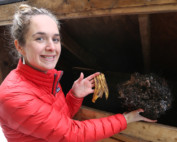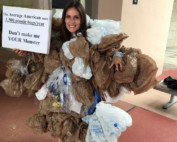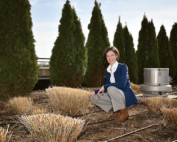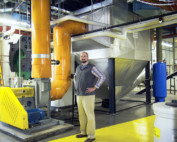
Dr. Tristan Brown, an assistant professor, teaches an energy resource assessment class. Students learn about renewable energy and conventional energy pathways.
THE U.S. Department of Labor lists wind farm technicians and managers as the nation’s fastest-growing occupations — an encouraging statistic for students in ESF’s sustainable energy management (SEM) major.
SEM combines the technical understanding of energy and making energy resources more sustainable while training students as professional managers of those resources, according to Michael Kelleher, senior research associate and ESF’s former executive director of energy and sustainability.
ESF’s program is the first in the nation to focus on the management aspect of energy systems, said Dr. David Newman, chair of the Department of Forest and Natural Resources Management, and that’s what makes it unique.
“Most of the energy programs have either been engineering programs or energy policy but not really energy management,” said Newman. SEM is also the College’s fastest-growing major. In the fall of 2016, there were 102 students in the SEM program. As many as 120 students are expected to be registered for the major for the fall of 2017.
Building off the success of the undergraduate program, the College is starting a graduate program in sustainable energy.
“I think it will be beneficial and advantageous in attracting graduate students,” Newman said. “We’ve been graduating students doing energy-related topics for a number of years, but now we’ll have a program directly related to their interests.”
Students who have graduated in SEM have found jobs as wireless regulatory specialists, photovoltaic technicians, energy analysts and energy conservation specialists. Others have entered graduate or law school.
SEM is an interdisciplinary major, with students taking classes from all perspectives of energy, finance, policy, environmental impact, current events and management, along with some design.
“This means they have to know this broad spectrum across all the disciplines that are involved in sustainable energy and also get that management perspective,” said Dr. Marie-Odile Fortier, an assistant professor who teaches in the program. “It allows them to become more effective as leaders in sustainable energy and energy management fields because then they can communicate across other disciplines.”
The SEM faculty reflects that vision. The group comprises two attorneys with Ph.D.s, a former energy manager with National Grid, a willow biomass scientist and Fortier as the engineer. “If they have a specific interest in something, they can really build up their knowledge from all different perspectives and be well-poised to enter that industry,” she said.
New this semester is the energy resource assessment class started by Dr. Tristan Brown, an assistant professor in FNRM. The class has a field study component through which students spend the semester learning about renewable energy and more conventional energy pathways. At the end of the semester, they visit a number of major energy systems including power plants and nuclear power plants.
“Students get to see energy systems, pathways in action,” said Brown. “We read about nuclear power, hydropower and fracking, but most people don’t get the opportunity to see these sites in action.”
Brown is also the lead investigator on a $906,000 U.S. Department of Agriculture grant investigating the commercial and environmental feasibility of converting willow and forest residues to bioenergy. The study will consist of a combination of primary data and a model to study the environmental impacts and the costs of the processes.
Fortier and Dr. Timothy Volk, director of the College’s willow project, are also working on the study. Students are being recruited to assist the study, giving them another way to learn about renewable energy.
“This is what the field is heading toward – interdisciplinary work where everything is connected,” said Fortier.
“We read about nuclear power, hydropower and fracking, but most people don’t get the opportunity to see these sites in action.” — Dr. Tristan Brown







